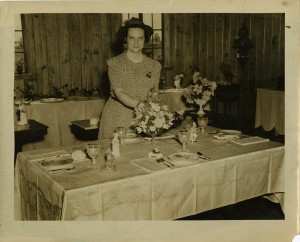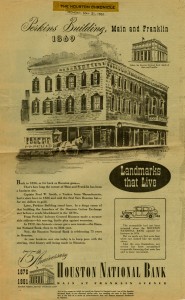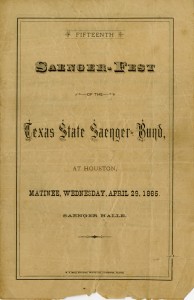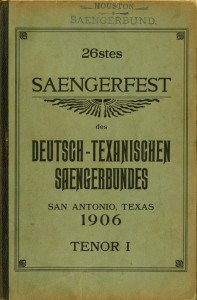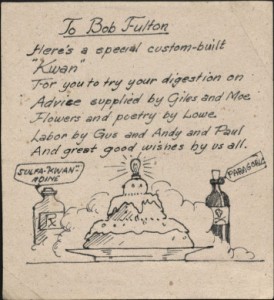
Do you watch Mad Men? A lot of us here in Special Collections do, and we noticed that on last night’s episode (no spoilers here, we promise) the book that Don Draper is reading on the airplane is Larry McMurtry’s The Last Picture Show. Not only do we have in our stacks a copy of that exact edition in Draper’s hands (a first printing of the Dell paperback from 1967),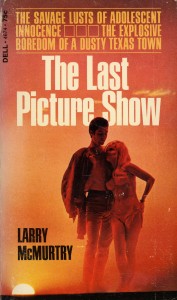 but we also have in our archives Larry McMurtry’s first draft of the typescript of the novel, complete with handwritten notes, a character list, an outline, and some discarded pages. Researchers and fans of McMurtry’s work can visit us here to follow the evolution of this novel from first draft to second draft to publisher’s copy, and compare these to the final published piece. (We highly recommend the 1971 film version of the book as well, available in the Anderson library’s DVD collection.)
but we also have in our archives Larry McMurtry’s first draft of the typescript of the novel, complete with handwritten notes, a character list, an outline, and some discarded pages. Researchers and fans of McMurtry’s work can visit us here to follow the evolution of this novel from first draft to second draft to publisher’s copy, and compare these to the final published piece. (We highly recommend the 1971 film version of the book as well, available in the Anderson library’s DVD collection.)
So, what does it mean for Don Draper to be reading The Last Picture Show? Well, we have some ideas, but don’t want to give away any spoilers in case you haven’t watched the episode yet.
Have you seen the tents in front of the grocery stores, bursting at the seams with blossoms and blooms? You had not forgotten, had you? She raised you better than that.
Mother’s Day is this weekend, April showers have brought on May flowers, and, as I cannot move about our fair city without the sweet waft of offerings for Mom in my nose, there seems no better time to highlight the work of some of Houston’s green thumbs. Their toiling ready to bear fruit, May is typically the time of year that garden and flower clubs in Houston begin to wind down their activities and meetings and take some time to bask in their handiwork.
In Houston, we are fortunate to be home to a number of garden and flower clubs that assist in the obvious, the beautification of the city, but also benefit the community in more subtle ways, through various service projects. In addition, historically these types of organizations have allowed for an arena of subtle political action for women. Having secured a right to vote early in the 20th century, equality remained elusive. Prior to the Women’s Liberation struggles of the 1960s, it was not uncommon to think a woman “unladylike” for vociferously proclaiming her political opinions or for simply asserting herself in the public sphere. These clubs and organizations, dominated by women and out of sight to about half the population, provided almost a parallel system of local political maneuvering. Members were able to negotiate and channel their politics through the selection of service projects and causes championed, thereby impacting public life.
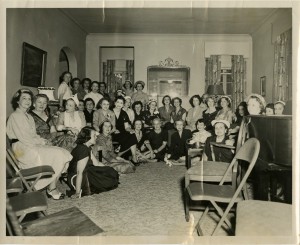
from the River Oaks Blossom Club Records
- The Carey C. Shuart Women’s Archive & Research Collection is proud to hold the archives of such organizations, with an eye towards beauty and enhancing society via service. For example, the Houston Council of Texas Garden Clubs worked on projects benefiting the U.S.V.A. Hospital and sponsored the Lighthouse for the Blind Garden Club. Meanwhile, the River Oaks Blossom Club members have donated their time and efforts to area hospitals, nursing homes, and even received recognition for their volunteer efforts during World War II.
The Houston Council of Texas Garden Clubs Records collects a number of scrapbooks and documents detailing the history and work of the chapter, including documents related to shows and service projects. The River Oaks Blossom Club Records date back to 1939 and include scrapbooks, yearbooks, photographs, and administrative files.
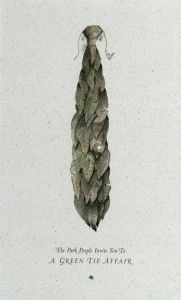
also available through our Digital Library as part of the Park People Annual Award Dinner Invitations
Of course, if all of this beauty has you reassessing your stewardship of the environment, and you want to make sure you’re taking care of that other Mother of yours, our Houston History Archives hold a number of resources documenting the environmental history and activism of the Houston and Gulf Coast region. Collection highlights there include the Park People Records, the Bayou Preservation Association, and, of course, the Terry Tarlton Hershey Papers.
Don’t forget to take care of your Mother on Sunday and be sure to come examine these wonderful resources and collections during the week. Caps and gowns are fluttering across campus, but we remain open and at your service Monday through Friday, 9am-5pm.
To mine, to yours, to all, a Happy Mother’s Day!
The finding aid for the Houston National Bank Records (1889-1964) has recently been published as part of our Houston and Texas History collection area. The records for the Houston National Bank, founded in 1876, contain administrative files as well as scrapbooks from individuals associated with the bank.
The Houston National Bank was founded in 1876, moved into the bustling and growing downtown area in 1928, and remained a financial cornerstone in the city until it merged with the Tennessee Bank and Trust Company in 1964. Its former home, a beautiful neoclassical construction of limestone on a black granite base, sat vacant as the 20th century came to a close. University of Houston alumnus Hakeem Olajuwan purchased the property and it now breathes new life as the Islamic Da’wah Center.
The Houston National Bank Records consist primarily of correspondence, photographs, news clippings, and promotional material related to the 75th and 85th anniversary celebrations in 1951 and 1961 respectively. Personal papers and scrapbooks belonging to the likes of former bank president Melvin Rouff round out the collection.
Of course, we are excited about this new finding aid. Please give it look and, should you find something of import to your research, please visit us at your earliest convenience.
This weekend the Houston Saengerbund Maennerchor will host the 67th annual Texas State Saengerfest in League City. Houston’s oldest music organization will lead this two-day celebration of German music and culture while showcasing new and original music from Rebecca Oswald, R. Michael Daugherty, and Carlie Hunder Burdett.
During the 19th century German immigrants were drawn to Texas, spurred on by a number of factors. Early settlers like Johann Friedrich Ernst (or Friedrich Diercks) sought independence and economic opportunity. Ernst’s letters home championed the cheap and readily available land through Empresario Austin, the mild winters, and the wide-open landscape teeming with game and natural resources. These letters were published in Germany and they spurred on a wave of wide-eyed optimists ready to make their new lives. Later, a number of colonization programs would try to capitalize on this popularity with Germans and ramped up immigration into Texas. By the 1890s rural German enclaves peppered across the Texas landscape while significant percentages of the population had been established in San Antonio, Galveston, and Houston, creating a virtual German Belt.
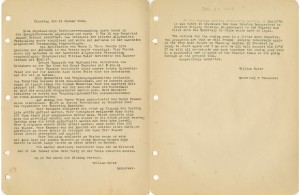
Houston Saengerbund meeting minutes reflecting the shift in name and language from German to English as the U.S. enters WWII
This German influx led to the establishment of a number of singing societies, not only in Texas but around the country, embracing the old Germanic culture of the Saengerfest. Those longing for the Fatherland could return home, if only in song, for those few happy hours of meeting and celebration. However, during the first half of the 20th century, membership numbers would reflect concerns over anti-German sentiment as horrific warfare dominated the European landscape and spilled over into the rest of the world. Shortly after the Japanese bombing of Pearl Harbor, the Houston Saengerbund changed their name to “The Houston Singing Society,” ceased singing German songs, and began using English as their official language of operation (as reflected in the recorded minutes). Following World War II, as tensions subsided, the club restored their official name and purpose — the celebration of German music.
Today, 130 years after its founding, the Houston Saengerbund continues that celebration.
At the University of Houston Special Collections, our Houston Saengerbund Records stand ready to share in that rich history of celebration. The collection contains materials dating back to the society’s inception up to the present day, including records, Saengerfest songbooks, and programs (some as early as the 19th century). Whether you are a vokalist looking to add to your repertoire or you just want a little sampling of the Vaterland, drop by Special Collections and have a look.
The latest digital collection containing materials related to the USS Houston, the Lt. Robert B. Fulton USS Houston Letters, is now available in the UH Digital Library. This collection contains letters Fulton wrote home prior to the sinking of the USS Houston (CA-30), along with other correspondence and documents.
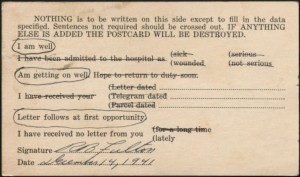
Fulton sent this postcard to his parents the week after the Japanese bombing of Pearl Harbor and the declaration of war on Japan by the United States.
Fulton was aboard the Houston when she was sunk by Japanese torpedoes in the Java Sea on Feb. 28, 1942, and he, along with more than 300 survivors of the sinking, was taken prisoner by the Japanese. Fulton spent most of the duration of the war in Zentsuji POW Camp in Japan before being liberated from Rokuroshi POW Camp on Sept. 7, 1945.
The heart of this collection is Fulton’s letters home. These provide insight into the experience of a naval officer on the USS Houston during the build up to war in the Pacific and during the conflict’s early months. Fulton describes daily activities on the ship, excursions and picnics, and the mounting tension in the area. Censorship prevents him from relaying the whereabouts or engagements of the ship.
Equally interesting are the colorful greeting cards Fulton received in POW camp, which contain handwritten messages and drawings.
Special Collections is dedicated to preserving and sharing the story of the Houston and her crew through archival and digital collections, as well as a permanent exhibit in M.D. Anderson Library. Additional digital library collections include the William Slough USS Houston Letters and the USS Houston Blue Bonnet Newsletters. While not related to the Houston, the Marine Bombing Squadron (VMB-613) Photos also contain World War II-related materials.
The original material for all these collections are available in Special Collections, which is open to the public. Be sure to take a look at these digital collections or come view the originals in our Reading Room.
